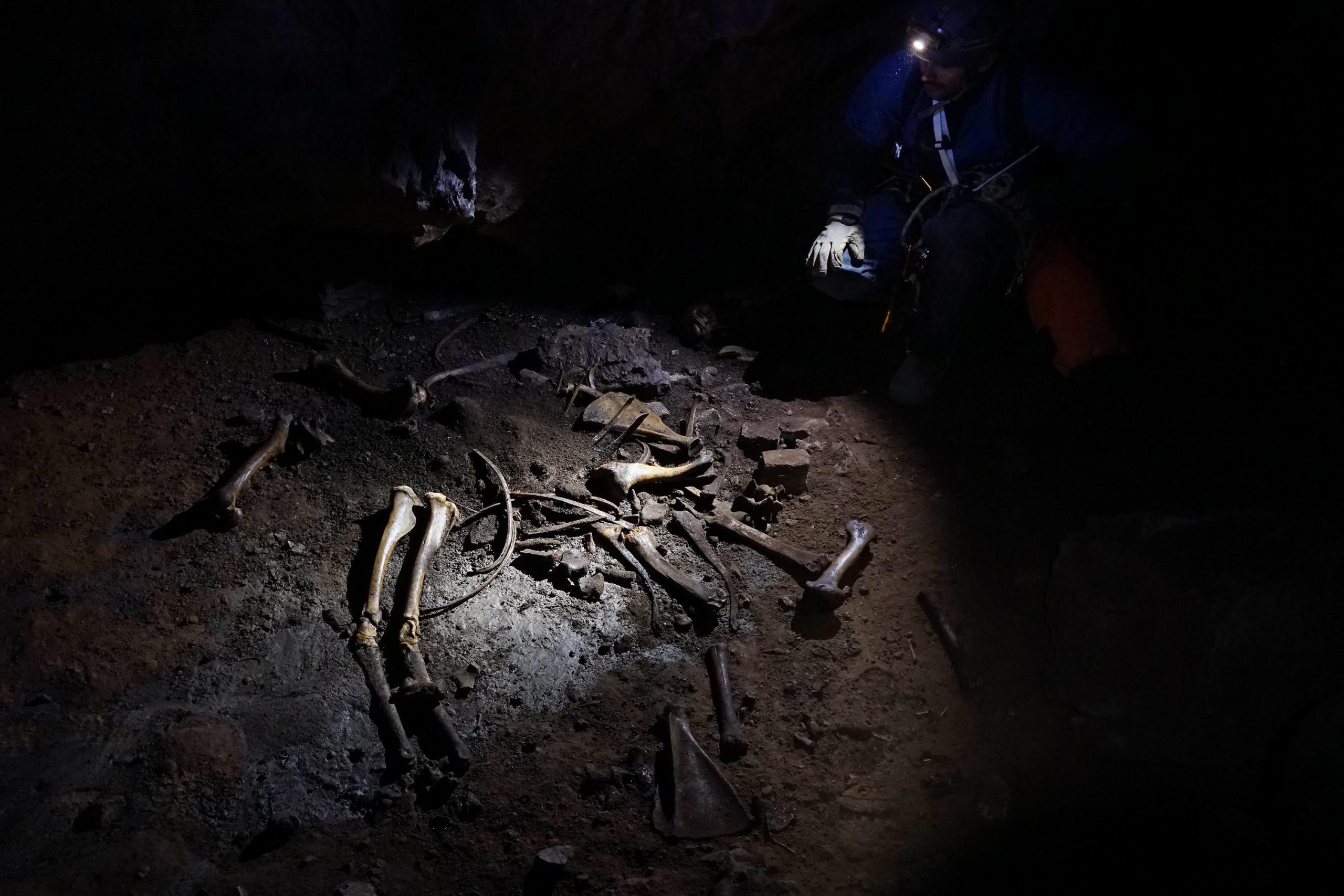Dr. Tyler Faith, NHMU’s chief curator, examines elk bones inside Skeleton Cave in the Uinta Mountains, Utah. Faith and a research team from NHMU collected bones from the site but left the elk skeleton in place given that it is the namesake of the cave. Credit: Randy Irmis
New study by NHMU utilizes cave data to set standards for understanding modern climate effects on mammal populations.
Scientists from the Natural History Museum of Utah have taken a deep dive into the not-so-distant past thanks to a friendly tip from Utah’s caving community. In a paper recently published in the Journal of Mammalogy, five scientists from the Natural History Museum of Utah (NHMU) and colleagues from Utah’s caving community have published the first research from their collaborative fieldwork effort deep in Utah’s caves.
Uncovering History in Caves: A New Perspective on Alpine Ecosystems
The journal’s feature article reveals why caves make such compelling research archives; what was uncovered in Boomerang Cave in northern Utah; why skeletal remains provide new access to hard-to-get data from the recent past; and offers a new zoological baseline for mammalian changes in an alpine community.
“To understand the impacts of climate on alpine ecosystems, we record current mammal species—mostly through trapping. But that method doesn’t tell us anything about the mammalian diversity in the recent past,” said Kaedan O’Brien, lead author and anthropology PhD candidate at the University of Utah. “So not a lot of study has been done on past alpine ecosystems because they are harder to get to, and when you do there is a slim chance of finding older skeletal remains intact.”

Dr. Tyler Faith, NHMU’s chief curator, rappels down a 150-foot cavern where a team of NHMU researchers examined bones of animals that once fell in and perished. Credit: Randy Irmis
In NHMU Chief Curator and paleoecologist Dr. Tyler Faith’s words, “We want to know what animals were there in the 1800s, but that’s nearly impossible in the absence of historical records. How do we document the recent past without a time machine?” An out-of-the-blue email from local caver and study co-author Eric Richards offered an unexpected method of time travel: repelling hundreds of feet down into Utah’s caves to find what may have fallen in—and when.
A Unique Collaboration: Cavers and Scientists Join Forces
In early 2019, Richards emailed NHMU Curator of Paleontology Dr. Randy Irmis to ask if he or the museum had any interest in the animal bones that he’d been finding on Utah cave adventures, and he sent photographs. Irmis replied right away, including colleagues Dr. Tyler Faith and O’Brien, a PhD student in Faith’s lab. The group met, hit it off, and after a couple of trial outings for equipment training, Faith and Irmis were lowering themselves into caves to collect bones of bygone animals.
“To be clear, this project would have never happened without the cavers reaching out to us, and investing time, and training with us. Eric and his wife Fumiko literally ‘showed us the ropes.’” said Faith. “I hope people realize that research isn’t just done by scientists who work at the museum, it can be public collaboration—in this case with trained experts (do not try this at home).”

Dr. Tyler Faith, NHMU’s chief curator, rappels into Boomerang Cave, Utah. Credit: Randy Irmis
After Faith obtained a research permit from the U.S. Forest Service in September 2019, Richards took the team to Boomerang Cave in the Bear River Range where they collected specimens for lab analysis at the museum. O’Brien managed the lion’s share of that work, upon which the paper is based.
Painstaking Analysis Yields Exciting Discoveries
“Identifying skeletal remains is painstaking work, because you just go bone by bone, sorting by size and element, and then comparing them with regional museum voucher specimens,” said O’Brien. But the result is exciting.
Using radiocarbon dating, fossils found in Boomerang Cave were shown to span the past 3,000 years, with the bulk from the last 1000 years or so. Comparison of these fossils to museum records and present-day mammals collected by co-authors and NHMU zoologists, Dr. Eric Rickart and Katrina Derieg, showed that the cave provided a faithful reflection of mammal diversity in the area. Perhaps most exciting is that the fossils also revealed the presence of species unknown to the region, like Merriam’s shrew. The full list of fossils is in the current Journal of Mammalogy, along with more on why this research matters.

Dr. Tyler Faith, chief curator of NHMU, squeezes through the narrow opening of an undisclosed cave where a team of NHMU researchers examined animal bones discovered within. Credit: Randy Irmis
“Our work highlights the value of collecting skeletal remains from caves as a convenient and accurate method for understanding the mammal communities,” said Irmis. “Caves help us create comprehensive and long-term records and better understand how animals have changed in the recent past.”
Reference: “The utility of alpine cave fossil assemblages for zoological census: an example from northern Utah, United States” by Kaedan O’Brien, Randall B Irmis, Joan Brenner Coltrain, Daniel Martin Dalmas, Katrina M Derieg, Thomas Evans, Eric S Richards, Fumiko M Richards, Eric A Rickart and J Tyler Faith, 21 November 2023, Journal of Mammalogy.
DOI: 10.1093/jmammal/gyad093
Faith, Irmis, and O’Brien credit the ongoing success of this research to the curiosity and generosity of Utah’s caving community. It’s another example of citizen science advancing research and developing long-term relationships between NHMU and the public.

Dr. Thomas Hughes is a UK-based scientist and science communicator who makes complex topics accessible to readers. His articles explore breakthroughs in various scientific disciplines, from space exploration to cutting-edge research.








